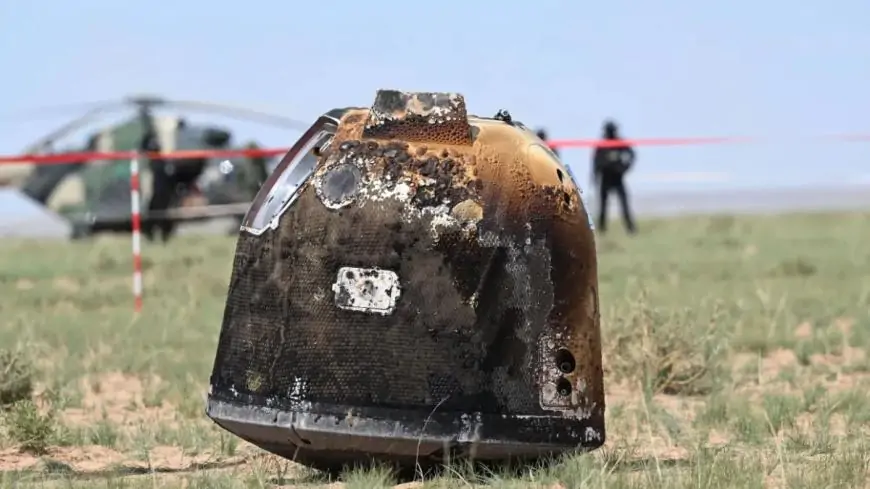China's Chang'e 6 lunar probe has returned to Earth, bringing with it samples from the unexplored far side of the Moon. So these are live pictures of the capsule re-entering orbit, Earth's orbit in the deserts or above the deserts of inner Mongolia and you can actually see it touching down on Earth as it descends and there it goes.
As you can see the parachute just collapsed and follow down to the ground there. So this is inner Mongolia in northern China, it's the northern Chinese region. Scientists say that they will very soon start to analyse the rocks and the soil that have been gathered from the lunar surface.
China is the only country actually to have landed on the far side of the Moon with this particular craft docking in a giant crater close to its south pole whilst it was there. I think it spent some two months in space. Well our China correspondent, our Beijing correspondent Laura Bicker has been following this story for us.
Hello there to you Laura, we're just looking at the live pictures there on the plains of inner Mongolia. This is a hugely significant step for the Chinese government. Yes this is a world first and China hasn't just landed on the far side of the Moon once, it's landed on the far side of the Moon twice.
The reason this is a world first is it's the first time they've managed to collect soil and rock samples. Now why is the far side of the Moon such a fascination with scientists? Well first of all it's thought that the rock composition is very very different to the side of the Moon that we can see. And the reason for that is the side of the Moon we can see the rock samples are a bit like that that you'd find in Hawaii or Iceland, they're volcanic in nature.
But scientists just don't know what kind of rock samples they'll see on the far side of the Moon. The other reason the far side of the Moon is of real interest is because it's very very difficult to get there. Now China launched a special satellite to allow it to communicate with the far side of the Moon.
Because it faces away from Earth it means that space centres here on Earth cannot communicate with the craft when it goes round that side of the Moon. So what China did was launch a satellite at that time to ensure that it could communicate.
The third thing that China was able to do was use that robotic arm and collect those raw rock and soil samples and enable it to put that back on the craft and as you see they've just landed on Earth and scientists will be able to research those samples.
This is a major step forward for China in its space ambitions. President Xi has described it as a Chinese dream. He believes that this is part of a space race to the Moon and certainly NASA officials have said back in May that there is a new race to the Moon between the United States and China.
Laura, it's often referred to as the dark side but it's not dark is it? I mean it gets its full share of light but do we know why they chose the South Pole to land? Is there any information as to why that particular landing site? It was because of the crater that is there it allowed them to land on that South Pole basin, Aitken basin and that's because it's got a massive crater that allowed them to land there and that's where the coordinates for the satellite came from. So it's one of the reasons why scientists have chosen that site, it would allow the probe to dig into that crater.
What they're hoping is that these rocks will be able to tell scientists about how the Moon and how planets are formed and that's why they want this particular rock sample and to analyse these particular rock samples. And yeah you're right, we have been told off by the science department to not call it the dark side of the Moon, it's the far side of the Moon, but when it comes to what we see that's probably why people at home are going, oh it is the dark side of the Moon. Okay, Laura Baker, thank you very much indeed, thank you.



![[WATCH VIDEO] Sophie Rain and sister Sierra Rain as Black Spiderman goes viral [WATCH VIDEO] Sophie Rain and sister Sierra Rain as Black Spiderman goes viral](https://www.sociallykeeda.com/uploads/images/202403/image_140x98_660976c59cce0.webp)





![[FULL WATCH VIDEO] Will Levis And Gia Duddy Leak Video Viral On Social Media [FULL WATCH VIDEO] Will Levis And Gia Duddy Leak Video Viral On Social Media](https://www.sociallykeeda.com/uploads/images/202405/image_140x98_6651e7ae8038d.webp)


